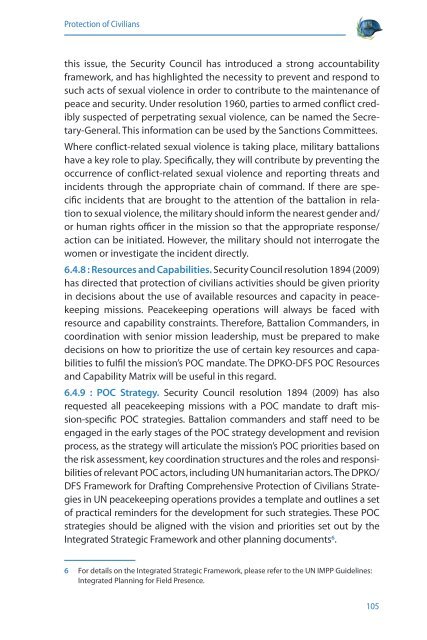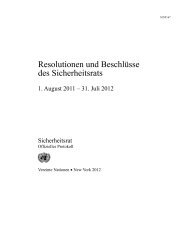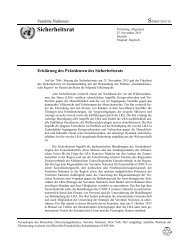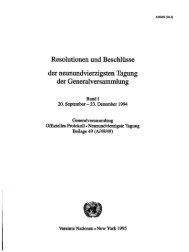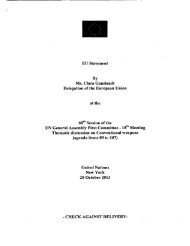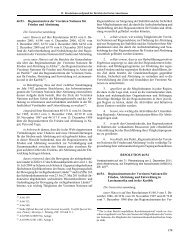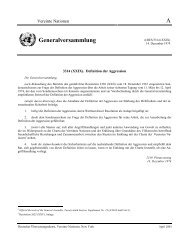United Nations Infantry Battalion Manual - the United Nations
United Nations Infantry Battalion Manual - the United Nations
United Nations Infantry Battalion Manual - the United Nations
You also want an ePaper? Increase the reach of your titles
YUMPU automatically turns print PDFs into web optimized ePapers that Google loves.
protection of civilians<br />
this issue, <strong>the</strong> Security Council has introduced a strong accountability<br />
framework, and has highlighted <strong>the</strong> necessity to prevent and respond to<br />
such acts of sexual violence in order to contribute to <strong>the</strong> maintenance of<br />
peace and security. Under resolution 1960, parties to armed conflict credibly<br />
suspected of perpetrating sexual violence, can be named <strong>the</strong> Secretary-General.<br />
This information can be used by <strong>the</strong> Sanctions Committees.<br />
Where conflict-related sexual violence is taking place, military battalions<br />
have a key role to play. Specifically, <strong>the</strong>y will contribute by preventing <strong>the</strong><br />
occurrence of conflict-related sexual violence and reporting threats and<br />
incidents through <strong>the</strong> appropriate chain of command. If <strong>the</strong>re are specific<br />
incidents that are brought to <strong>the</strong> attention of <strong>the</strong> battalion in relation<br />
to sexual violence, <strong>the</strong> military should inform <strong>the</strong> nearest gender and/<br />
or human rights officer in <strong>the</strong> mission so that <strong>the</strong> appropriate response/<br />
action can be initiated. However, <strong>the</strong> military should not interrogate <strong>the</strong><br />
women or investigate <strong>the</strong> incident directly.<br />
6.4.8 : Resources and Capabilities. Security Council resolution 1894 (2009)<br />
has directed that protection of civilians activities should be given priority<br />
in decisions about <strong>the</strong> use of available resources and capacity in peacekeeping<br />
missions. Peacekeeping operations will always be faced with<br />
resource and capability constraints. Therefore, <strong>Battalion</strong> Commanders, in<br />
coordination with senior mission leadership, must be prepared to make<br />
decisions on how to prioritize <strong>the</strong> use of certain key resources and capabilities<br />
to fulfil <strong>the</strong> mission’s POC mandate. The DPKO-DFS POC Resources<br />
and Capability Matrix will be useful in this regard.<br />
6.4.9 : POC Strategy. Security Council resolution 1894 (2009) has also<br />
requested all peacekeeping missions with a POC mandate to draft mission-specific<br />
POC strategies. <strong>Battalion</strong> commanders and staff need to be<br />
engaged in <strong>the</strong> early stages of <strong>the</strong> POC strategy development and revision<br />
process, as <strong>the</strong> strategy will articulate <strong>the</strong> mission’s POC priorities based on<br />
<strong>the</strong> risk assessment, key coordination structures and <strong>the</strong> roles and responsibilities<br />
of relevant POC actors, including UN humanita ri an actors. The DPKO/<br />
DFS Framework for Drafting Comprehensive Protection of Civilians Strategies<br />
in UN peacekeeping operations provides a template and outlines a set<br />
of practical reminders for <strong>the</strong> development for such strategies. These POC<br />
strategies should be aligned with <strong>the</strong> vision and priorities set out by <strong>the</strong><br />
Integrated Strategic Framework and o<strong>the</strong>r planning documents6 .<br />
6 For details on <strong>the</strong> Integrated Strategic Framework, please refer to <strong>the</strong> UN IMPP Guidelines:<br />
Integrated Planning for Field Presence.<br />
105


